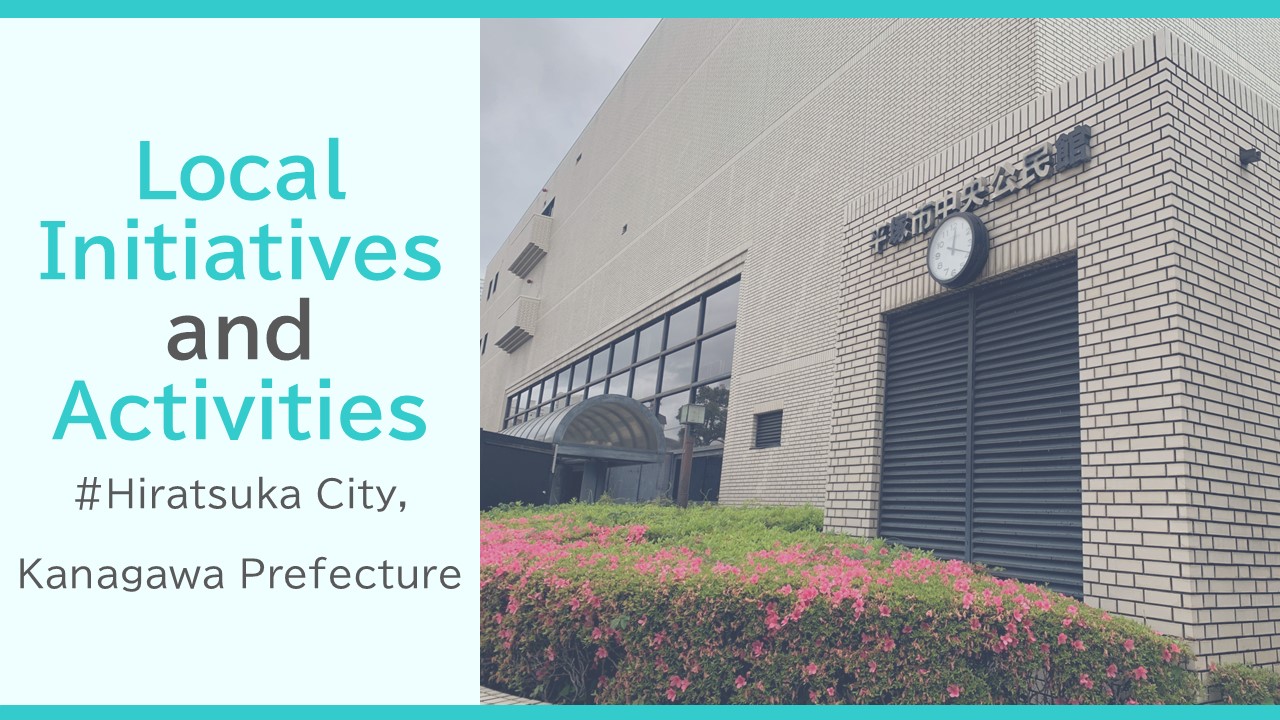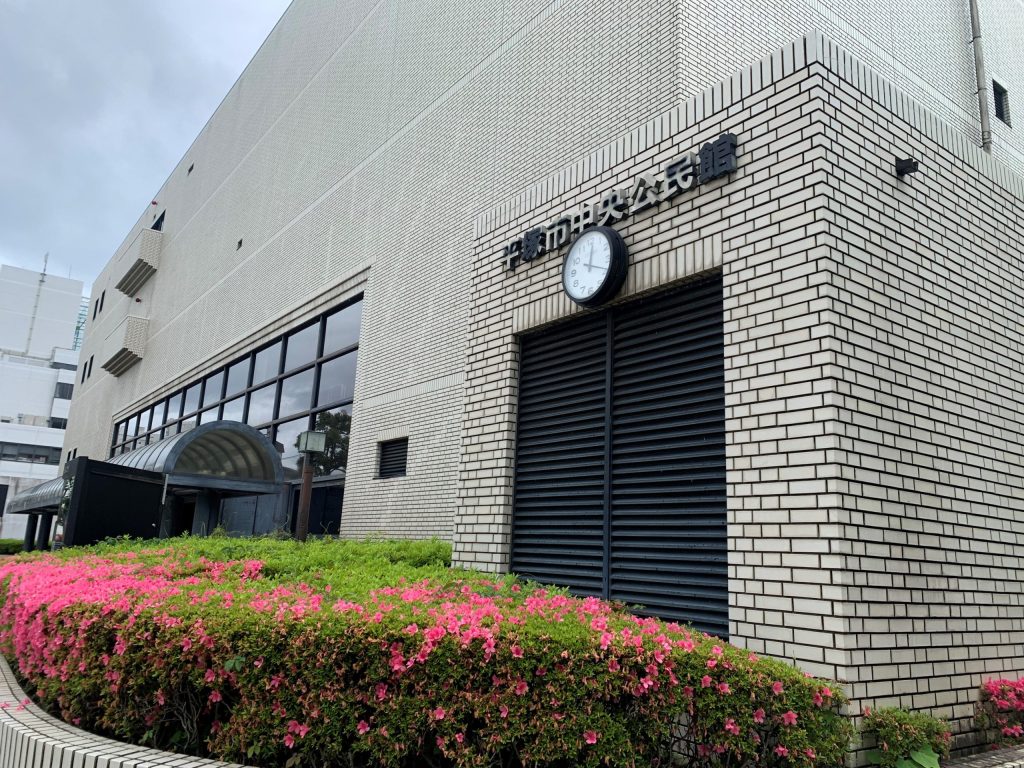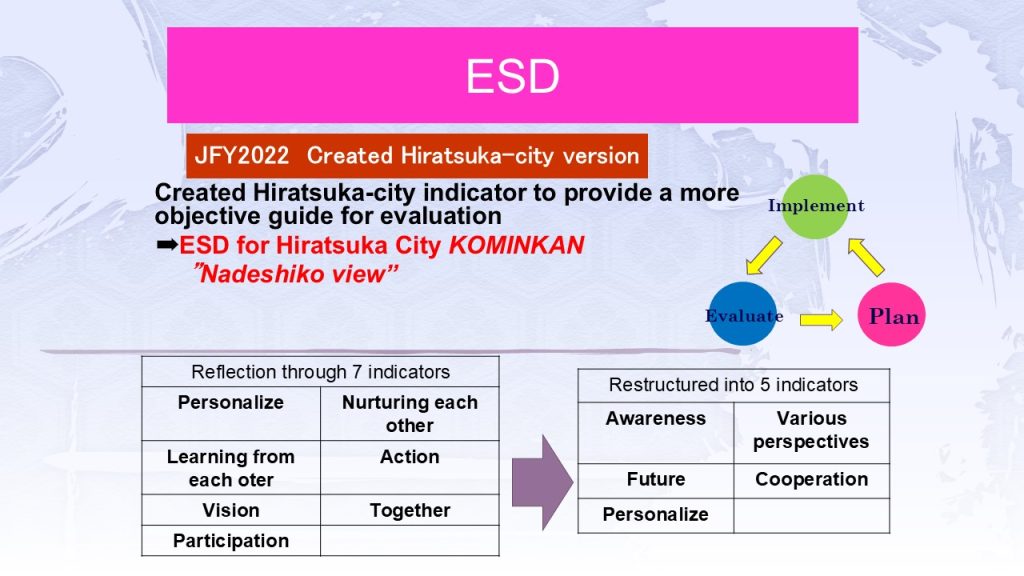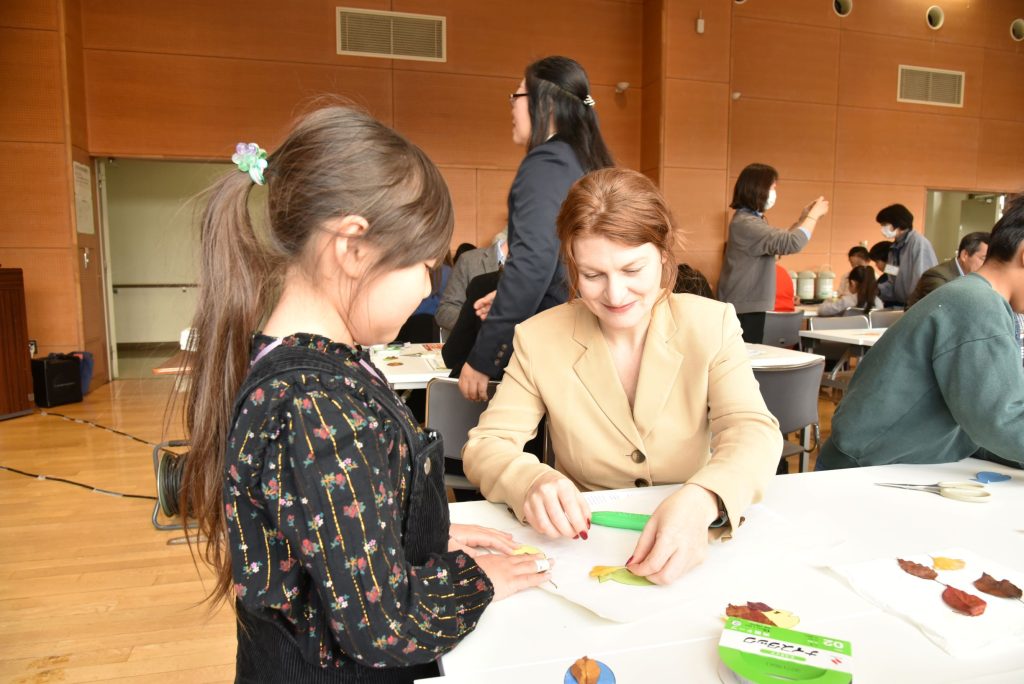
Expanding Community Learning Centre Activities through ESD in Hiratsuka City: From Local to Global
When most people hear the term “Education for Sustainable Development (ESD),” they likely associate it primarily with school-based education. However, this article introduces the initiatives in Hiratsuka City, where CLC are actively promoting ESD!
Hiratsuka City, located in the central shonan region of Kanagawa Prefecture, is surrounded by the sea and mountains, offering a rich natural environment. A unique feature of the city is its extensive Community Learning Centre (CLC) or kominkan system, with one CLC in almost every primary school catchment area, a rarity in neighboring cities.
From 2019 to 2021, The Asia-Pacific Cultural Centre for UNESCO (ACCU) implemented the ESD Promotion Project in Hiratsuka City as part of the UNESCO Bangkok Office’s Community-based Education for Sustainable Development (ESD) project. This participation provided an opportunity for Hiratsuka to rethink and further develop existing CLC projects from the global lens of ESD. As a result, Hiratsuka was chosen as a field visit site for the ESD-Net2030 global meeting organized by UNESCO and the Ministry of Education, Culture, Sports, Science and Technology of Japan in December 2023.
Below is an interview article of Mr. Takeshi Ebisawa (former deputy director of Hiratsuka Central Kominkan), who has hands-on experience with ESD initiatives in Hiratsuka’s CLCs through his work at the City Board of Education. Mr. Ebisawaw also presented on Hiratsuka’s ESD initiatives at a thematic event during UNESCO Week 2023. You can watch the archived video here (link to YouTube).

Hiratsuka Central Kominkan
Secretariat of UNESCO Future Co-creation Platform (hereafter Secretariat): Thank you for taking the time to speak with us today. After listening to your presentation at the UNESCO Week 2023 thematic event, I was struck by how the ESD perspectives in Hiratsuka City seem to have taken root through an ‘evolution’ rather than just a ‘change.’ Were there any challenges or innovations in adopting this approach?
The turning point for us came when we visited Okayama, a pioneer in community-based ESD, as part of a UNESCO Bangkok Office and ACCU initiative. There, we learned that the CLC in Okayama was doing very similar work to what we were doing in Hiratsuka. Through exchanges with colleagues, I realized that integrating ESD into our activities didn’t have to negate what we had already built over the years. If the goal had been to say, “What we’ve been doing is wrong, let’s do something completely different,” it probably wouldn’t have been accepted. The visit to Okayama helped our staff see that our CLC activities could be further refined by viewing them as an extension of what we were already doing.
Secretariat: I understand that the CLC in Hiratsuka City uses five indicators based on the “Nadeshiko (daphne flower) view” to evaluate projects. Could you tell us about the process of creating these indicators and how the learners responded to them?
Initially, we used seven indicators based on the advanced system from Okayama. However, we wanted to make the process more relatable to Hiratsuka. We chose the nadeshiko flower, which symbolizes Hiratsuka’s citizens, as a motif, and we sought to identify what made Hiratsuka attractive. It took about a year to develop an evaluation system that was unique to Hiratsuka. We collect feedback from learners through surveys and other methods. Over time, learners became more familiar with the term “ESD,” and their responses shifted from simply saying “that was fun” to expressing a desire to take action, such as, “Let’s do something good for the environment” “Let’s do it at home.” Their understanding of ESD deepened through repeated exposure to the concept.

‘ESD Evaluation Forum’ at UNESCO Week 2023 (23 February 2023) – Excerpts from the presentation “Evaluation of ESD in Social Education [Hiratsuka City, Kanagawa Prefecture]”
Secretariat: It seems that the ESD evaluation helped shift learners’ perspectives, leading them to think not just about enjoying the activities, but also about continuing them. Was this the case?
Yes, that’s right. Some learners even expressed a desire to teach others, saying “I learned something valuable and want to share it with others.” This aligns with the concept of ‘sustainability.’ There is also interaction between children, who have learned about the SDGs in school, and the adults and CLC staffs, with children suggesting, “We learn about this at school too,” or “It would be great if we could do something like that here.”

Photo provided by: Hiratsuka City, Activities using fallen leaves at Ohara Kominkan in Hiratsuka City. Mr. Ebisawa recalls that the project “actively involved the local community, connected to school education, and had a strong ESD component.”
Secretariat: In the 19 January 2024 edition of “Koho Hiratsuka,” a PR magazine of Hiratsuka City (link to Hiratsuka City website), you mentioned, “We felt that if the CLC staffs took the words ESD and UNESCO too seriously, the conversation wouldn’t progress, so we think about ways to incorporate them in a more relaxed way” (p.4). This point resonates with many people working on UNESCO-related activities. How did you find a way to incorporate these concepts “in a more relaxed way”?
It’s about accumulating experiences and engaging in hands-on activities. We continue to approach our work in the same way we’ve always done, maintaining the same stance. The Nadeshiko view evaluation is a good example—while we add new elements and refine it over time, it remains part of an ongoing ‘cycle.’ We believe that the starting point for this cycle can be anywhere, and this approach has helped us stay relaxed and open to growth, rather than focusing solely on immediate results.
Secretariat: The UNESCO Future Co-Creation Platform project aims to promote cross-disciplinary cooperation, such as between ‘education and culture’ or ‘education and science.’ Are there any ESD projects in Hiratsuka City that involve culture or science?
In the area of ‘education and science,’ we held a ‘Science Classroom’ of Tokai University, where university students served as the teachers. This gave younger individuals the opportunity to teach in the community, and seeing the learners’ reactions motivated the students to think about what to teach next. We hoped this would spark an interest in science for children.
As for ‘education and culture,’ the boundaries can be a bit unclear, but traditional cultural experiences are offered at CLCs across the city. We have classes in tea ceremony, flower arrangement, and even Go, a kind of Japanese board game, as Hiratsuka is known for its Go culture.

Secretariat: Do you think the CLC activities lead to wellbeing, a sense of purpose, and overall satisfaction?
Many people naturally want to volunteer and help out at the CLC. By participating in these activities and connecting with others, they feel a sense of satisfaction, which in turn boosts the wellbeing of the whole community.
Secretariat: What do you think about the significance and value of implementing the global framework of ESD in the local context as ‘local initiatives’?
Both global and local frameworks are essentially doing the same thing within their scope. I believe that the accumulation of local efforts contributes to global progress.
Secretariat: I see. As you mentioned earlier, the desire to help others and be useful to the community begins locally through these activities and may eventually lead to a broader, global movement.
Exactly. It’s the accumulation of small actions that leads to a global impact.
Secretariat: We often focus on ‘differences,’ but ‘commonalities’ might be more important. Perhaps the concept of ‘global’ doesn’t need to be so grandiose.
When people realize they have something in common, it makes them feel more connected and capable of taking action. I believe this is a positive thing, and in this sense, the local efforts can indeed spread globally.
After the Interview
ESD is not a fixed concept that people should follow; rather, it acts as a trigger or a tool, expanding into a cycle that grows. In this interview, we’ve learned how local initiatives can lead to global. No matter how many tools you have, it’s the people who bring them to life. In Hiratsuka’s case, the visit to Okayama wasn’t just about ‘sharing of tools.’ It was about the people of Hiratsuka taking initiative, refining their CLC activities from an ESD perspective, which I believe is truly significant.
In this article series, Local Initiatives, we’ll continue to focus on how local initiatives and community-driven actions are connected to global efforts!
*This is an English translation of an article that was originally written and published in Japanese on 28 October 2024. (https://unesco-sdgs.mext.go.jp/column/local-initiatives-20241028)
DATA
| Date | Tuesday, 28 May 2024 |
|---|---|
| Place | Hiratsuka Central Kominkan |
| Speaker | Takeshi Ebisawa (former acting director, Hiratsuka Central Kominkan) |
| Interviewer | Kiichi Oyasu and Maho Arai (Secretariat of UNESCO Future Co-creation Platform) |
| Reference | Koho Hiratsuka (19 Jan 2024), Special Feature: “ESD at the Community Learning Centre.” (Japanese only) |
